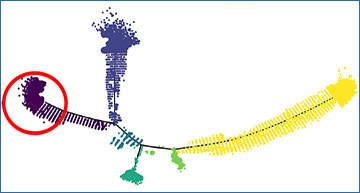
From Alzforum by Chelsea Weidman Burke
As the mountain of single-nucleus RNA-sequencing data grows taller, how can scientists extract meaning from it? One way is pseudotime analysis. In essence, this algorithm orders cells on a virtual timeline based on the similarity of their gene-expression patterns. “Cells that are alike are placed near each other along the spectrum of transcriptional changes,” explained Laura Heath of Sage Bionetworks in Seattle. Heath presented one of several pseudotime analyses currently being done in the Alzheimer’s field at the Alzheimer’s Association International Conference, held last month in San Diego, California.
The resulting diagrams look like trees. Scientists call branches healthy or diseased based on their expression of known markers. This, in turn, places each cell along the health to disease trajectory, exposing sequential gene expression patterns.
Pseudotime analysis allows scientists to turn cross-sectional data into “faux” longitudinal data to understand how cells change over time. This is important for Alzheimer’s, a disease that unfolds over the course of 30 years. Postmortem tissue offers but a snapshot of one time point, making it hard to discern when and how disease markers develop. Most brain transcriptomic data come from postmortem samples and are likewise difficult to interpret because it is hard to know if gene-expression changes are due to AD pathogenesis or organ damage associated with the end of life.




